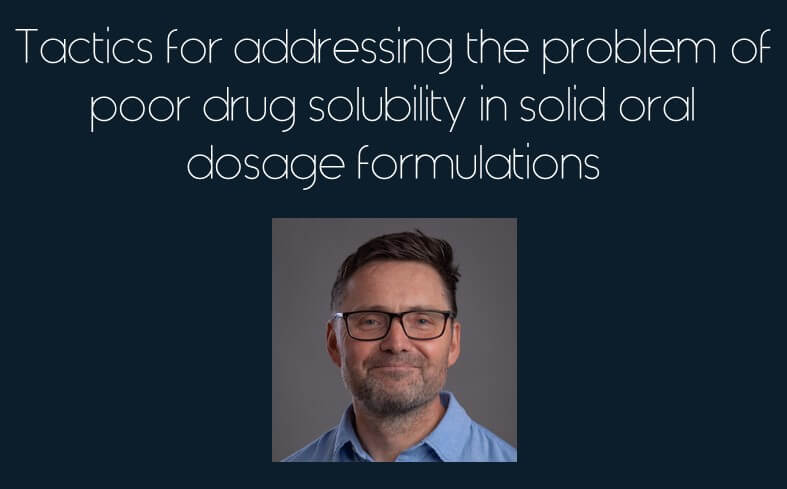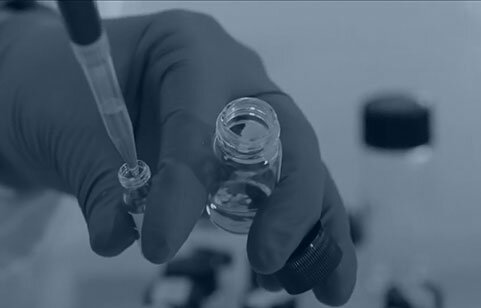
Tactics for addressing the problem of poor drug solubility in solid oral dosage formulations
Whilst good solubility is a target property in many drug discovery programs, a balance is often struck between solubility and potential efficacy which means that a poorly soluble molecule may need to be progressed. Poor drug solubility is often cited as a reason for failure of an asset in development.1 However, many techniques exist to increase solubility.

What is a poorly soluble drug?
If insufficient drug dissolves in the gastrointestinal tract then a therapeutic dose may not be achieved. If this occurs, the drug is defined as poorly soluble. The two important pieces of information being the solubility in biorelevant media and the desired dose.
The Biopharmaceutical Classification System (BCS) offers a useful shorthand to understand how the solubility and permeability of a drug might impact plasma concentration. The closely related Developability Classification System (DCS)2 is also useful. This discriminates drugs not only on permeability and solubility, but also solubility rate limitation. In the BCS system, poor solubility is defined as BCS 2 and 4 (DCS 2a/b and 4). In such cases, solubility enhancement (often called bioenhancement or an enabled formulation) may be required.
How can solubility be enhanced?
Salt or cocrystal formation
Salts of drugs have been utilised for many years to facilitate physical handling of a drug and to increase solubility. Generally, the introduction of a charged moiety into a molecule increases aqueous solubility. A more recent innovation is the use of cocrystals where an organic molecule is introduced as a cocrystal ‘former’ to generate a new molecular crystal where the drug and conformer are linked through hydrogen, not ionic bonding.3 This approach can be used to increase solubility.
An example of a marketed drug which is commercialised as a cocrystal form is Entresto.4
Particle size reduction
The problem of solubility rate limitation occurs where the thermodynamic solubility of the drug is sufficient for exposure but where the rate of dissolution is too slow compared to transit time in the gastrointestinal tract. In the DCS, drugs like this are denoted as Class IIa. In such cases, size reduction techniques such as micronization, normally using a fluid energy mill, can be deployed to reduce particle size and increase the available surface area of the drug which in turn increases the rate of dissolution.5
An example of this is the antifungal Griseofulvin.
Amorphous dispersion
If a drug isn’t crystalline then there is no lattice energy to overcome on dissolution and apparent solubility will be higher. This is the basis of utilising amorphous drug, commonly dispersed in a suitable polymer which can behave functionally to provide a bulking agent and impart chemical and physical stability. Dispersions are created using spray drying or hot melt extrusion and are often the first approach to be tried if solubility enhancement is needed. This is becoming increasingly popular for oncology assets many of which are poorly soluble.6
There are many examples of marketed drugs which use amorphous dispersion technology including Crestor, Rezulin and Cymbalta.
Nanoparticles
The thermodynamic solubility of a drug in a specific medium remains constant at a given temperature for particle sizes larger than 1um. At the sub-micron level, however, the Ostwald-Freundlich equation predicts increased equilibrium solubility. This is the basis for utilising nanoparticles to enhance solubility.7 Common techniques for manufacturing nanoparticles include wet bead milling and high pressure homogenization.
Commercialised drugs using this approach include Aprepitant.
Cyclodextrins
Cyclodextrins are cyclic oligosaccharides made up of dextrose units of (α-1,4)-linked α-Dglucopyranose.8 These cyclic structures contain a lipophilic central cavity and a hydrophilic outer surface. Lipophilic drug molecules can be complexed in the central cavity whilst the hydrophilic surface imparts increased aqueous solubility. This is the mechanism by which cyclodextrins increase apparent solubility.
Formulations of cetirizine have been marketed using β-Cyclodextrin.
Self-emulsifying Drug Delivery Systems (SEDDS)
SEDDS are isotropic mixtures of oil, surfactants, solvents and co-solvents/surfactants. The principal characteristic of these systems is their ability to form fine oil-in-water (o/w) emulsions or microemulsions upon mild agitation following dilution by an aqueous phase. Lipophilic drugs dissolve in the oil phase and are therefore delivered as a solution which dispenses with any solubility or dissolution rate limitation. SEDDS are normally prepared as liquid dosage forms that can be administrated in soft gelatine capsules.9
Choosing the right technique to increase poor drug solubility
The ideal technique for enhancing solubility would be one that delivers not only the required biopharmaceutical performance of the formulation but also chemical and physical stability and manufacturability. In addition, simplicity is important; the more complex a manufacturing process is, the more expensive it is, the opportunity for failure is greater and the more difficult it becomes to demonstrate control over critical quality attributes. Each technique carries advantages and disadvantages which need to be carefully evaluated before committing to clinical supply.
CatSci project teams work collaboratively to integrate process chemistry solutions with key decisions in formulation development.
We have also created our own Digital Risk Assessment Tool, SmartPath. SmartPath is the smart way to risk assess your API, project and formulation data. With SmartPath, you can focus on what matters most: delivering your asset to the next step, without surprises or delays.
Want To Find Out More?
Watch our symposium: Material Science in Drug Development: A Holistic Approach
Contact us at enquiries@catsci.com or explore our capabilities.
You can find Robert’s blog post on how to make sure salt screens are as effective as possible here.
Author: Dr Robert Dennehy, Director of Material Sciences at CatSci Ltd.
References
- Martin K. Bayliss et al., Quality guidelines for oral drug candidates: dose, solubility and lipophilicity. Drug Discovery Today. 2016 21(10), 1719-1727.
- Julian Rosenberger et al., A Refined Developability Classification System. J. Pharm Sci. 2018 107 (8) 2020-2032.
- Oisin N Kavanagh et al., Pharmaceutical cocrystals: from serendipity to design to application. Drug Discovery Today. 2019 (24)3 796-804.
- https://www.ema.europa.eu/en/documents/assessment-report/entresto-epar-public-assessment-report_en.pdf
- Chaumeil J.C., Micronisation: a method of improving the bioavailability of poorly soluble drugs. Methods and Findings in Experimental and Clinical Pharmacology. 1998 20 211-215.
- Robert O. Williams et al., Harnessing the therapeutic potential of anticancer drugs through amorphous solid dispersions. BBA – Reviews on Cancer. 2020 1873(1) 188319
- M. A C Deleers, Nanoparticulate Drug-Delivery Systems in Drugs and the Pharmaceutical Sciences volume 166, Academia.
- Jacob S et al., Cyclodextrin complexes: Perspective from drug delivery and formulation. Drug Dev Res. 2018 79 201–217.
- Jing-ling Tang et al., Self-Emulsifying Drug Delivery Systems: Strategy for Improving Oral Delivery of Poorly Soluble Drugs. Current Drug Therapy. 2007 2 85-93